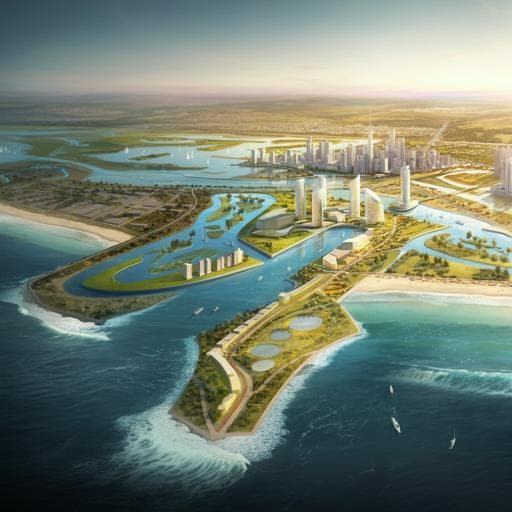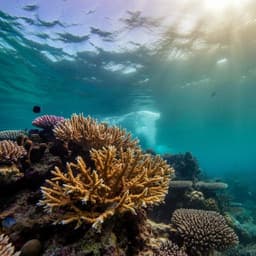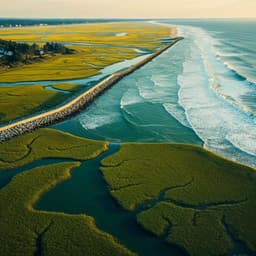
Environmental Studies and Forestry
Protection and restoration of coastal habitats yield multiple benefits for urban residents as sea levels rise
A. D. Guerry, J. Silver, et al.
This study, conducted by A. D. Guerry, J. Silver, J. Beagle, and others, reveals how nature-based solutions can significantly enhance adaptation to rising seas in coastal areas. With up to eight times the benefits compared to traditional engineering methods, this research highlights essential tools for evaluating the multiple advantages of these innovative approaches in urban estuaries.
~3 min • Beginner • English
Introduction
Cities face increasing risks from sea-level rise, with one billion people living less than 10 m above current high tide lines and many megacities near coasts. While impacts are global, adaptation is planned and implemented locally, creating challenges for municipalities balancing competing priorities and limited resources. Nature-based solutions (NBS)—protecting, managing, restoring, or creating ecosystems such as marshes, beaches, and hybrid systems like ecotone levees—can reduce coastal risk while delivering co-benefits including carbon sequestration, recreation, and biodiversity support. Implementing NBS in urban areas faces biophysical constraints (limited space, coastal squeeze, reduced sediment supply) and institutional barriers (fragmented ownership and governance, regulatory hurdles, funding constraints), as well as environmental justice concerns including potential eco-/climate gentrification. The San Francisco Bay Area, and specifically San Mateo County, is highly exposed to sea-level rise with significant assets and vulnerable populations at risk, alongside a history of hardened shorelines and growing interest in green/hybrid strategies. To inform adaptation planning, the authors partnered with regional stakeholders to co-develop guiding principles and asked three questions: (1) how does exposure to sea-level rise vary along San Mateo County’s Bay shore? (2) where are nature-based solutions feasible in this highly urban environment? and (3) what additional benefits (ecosystem services) might NBS provide relative to traditional engineered solutions? Addressing these questions can guide where and how NBS can be integrated into urban adaptation to achieve risk reduction and multiple social-ecological benefits.
Literature Review
The paper situates NBS within a growing body of research demonstrating the protective role of coastal habitats (e.g., marshes attenuating waves and reducing storm impacts) and their multiple co-benefits (biodiversity, recreation, carbon). It reviews constraints on NBS in urban contexts such as coastal squeeze, sediment starvation, and regulatory barriers that can impede beneficial sediment use. It also highlights environmental justice scholarship on eco-/climate gentrification linked to green infrastructure and resilience projects, noting limited attention to coastal NBS in this context. In the Bay Area, existing assessments (e.g., BCDC’s regional vulnerability analysis, the Shoreline Adaptation Atlas using Operational Landscape Units) provide frameworks to evaluate exposure and biophysical suitability for NBS. Restoration costs are substantial, underscoring the need to quantify multiple benefits to justify investments and sustain support. The study builds on this literature by integrating suitability analyses, scenario development, and ecosystem service modeling at subregional scales for an urban estuary.
Methodology
Co-production and engagement: The team worked with San Mateo County’s Office of Sustainability and diverse stakeholders (city/county planners, public works, NGOs, land managers) to co-develop six guiding principles for adaptation, gather feedback on suitability of NBS, and co-create spatially explicit scenarios. Engagement occurred through multiple meetings across the County.
Exposure assessment: Using the County’s Sea Change Vulnerability Assessments, exposure to a 1% annual chance flood (baseline), plus scenarios with baseline +1 m and +2 m sea-level rise (all with the 1% storm) was summarized for the County’s five Operational Landscape Units (OLUs). Analyses were recast from city/asset to OLU scale to reflect geophysical connectivity.
Suitability analysis: Building on the San Francisco Bay Shoreline Adaptation Atlas, the team summarized biophysical suitability within OLUs for five NBS types: tidal marsh restoration/creation, ecotone levees, coarse beaches, nearshore reefs (e.g., oysters), and submerged aquatic vegetation (eelgrass). Suitability considered water depth, substrate, wave climate, historical habitats, and current shoreline development. Social feedback further refined biophysical suitability to reflect feasibility, existing protection, and local knowledge.
Scenario development: Three countywide, spatially explicit adaptation scenarios were co-developed and designed to provide equivalent flood protection (no overtopping under a 100-year FEMA storm with 1 m sea-level rise), holding flood performance constant while varying measures.
- Scenario 1 (“What we might have done”): a fully hardened shoreline by 2050 (about 130 km of levees/seawalls), ignoring existing/planned marsh restoration.
- Scenario 2 (“What we are doing”): includes existing and planned restoration/conservation projects together with existing/planned hard structures (~106 km hardened shoreline) to quantify benefits already being realized or planned.
- Scenario 3 (“What we could do next”): adds additional feasible NBS based on suitability and stakeholder feedback, reducing hardened shoreline to ~79 km (about 60% of Scenario 1), using hybrid combinations where needed.
Assumptions included marshes accreting sufficiently to keep pace with sea-level rise through 2050, need for management beyond 2050, and no major upland land-use change.
Ecosystem service and habitat modeling:
- Stormwater nutrient pollution reduction: InVEST Urban Stormwater Retention model at 30 m resolution mapped nitrogen loads (kg N/yr) from precipitation, land cover, and soils, applying empirical Bay-specific marsh removal rates to loads discharged within 100 m of marsh.
- Recreation: InVEST Recreation model quantified standardized unique Flickr photo-user-days (PUD) in 500 m shoreline-centered hex cells (2005–2017) as a proxy for visits. A count multiple regression related visitation to shoreline type (e.g., seawall, marsh, beach, horizontal levee), controlling for population and access, and was used to predict recreation under each scenario.
- Carbon sequestration: InVEST Coastal Blue Carbon estimated carbon storage/sequestration in aboveground biomass, litter, and soil pools, using Bay/California/global parameters. New marsh in Scenarios 2–3 was assumed established by 2030, with sequestration from 2030–2050; uniform initial pools and linear soil accumulation; no biomass/litter accumulation over time.
- Habitat for Ridgway’s Rail (endangered): A simple linear regression related rail occurrence to marsh area (marsh explained ~80% of occurrence; p<0.01). Estimated rail habitat area under each scenario from the marsh-habitat relationship.
Data/code availability: Data hosted on OSF (https://osf.io/jsx9m/). InVEST source code on GitHub (https://github.com/natcap/invest).
Key Findings
- Nature-based scenarios deliver substantially higher co-benefits than an engineered baseline with equivalent flood protection. Relative to Scenario 1 (engineered baseline):
• Scenario 2 (“What we are doing”): ~5x marsh area (Ridgway’s Rail habitat), +50 ha beach, ~6x stormwater runoff retention (nutrient reduction), ~5x carbon sequestration, and overall similar total recreation (1x), though with spatial variation by OLU.
• Scenario 3 (“What we could do next”): ~6x marsh area, +200 ha beach, ~8x stormwater runoff retention, ~6x carbon sequestration, and overall similar total recreation (1x).
- Recreation effects vary geographically: northern OLUs tend to gain or maintain visitors with added beaches (Scenarios 2–3), while southern OLUs tend to lose visitors as marsh areas expand; beaches correlate with higher visitation, marshes with lower visitation. Engineered shorelines with trails attract more visitors than those without.
- OLU-specific patterns: Belmont–Redwood OLU concentrates existing/potential marsh, driving higher carbon sequestration, nutrient retention, and rail habitat but lower recreation. Yosemite–Visitacion OLU lacks marsh potential due to deep water/high wave energy but has significant beach access and ~50% of County’s modeled recreation; suitability indicates potential for ~43 ha additional beach restoration, increasing recreation in Scenario 3.
- Biophysical suitability: Across OLUs, beaches, ecotone levees, and tidal marsh restoration are suitable in 4/5 OLUs; submerged aquatic vegetation in 3/5; nearshore reefs in 2/5.
- Hardened shoreline length can be reduced with NBS: Scenario 3 uses ~79 km of hardened shoreline (60% of Scenario 1), with bayward edges softened by NBS and hybrid designs.
- Engagement outputs (maps, scenarios, fact sheets) served as boundary objects, aiding stakeholder understanding and planning; some projects (Scenario 2) are underway with potential full implementation by ~2030.
Discussion
The study demonstrates that co-developed, OLU-based adaptation planning that integrates nature-based and hybrid solutions can yield multiple ecosystem services while maintaining flood protection comparable to traditional gray infrastructure. By mapping exposure, biophysical and socially feasible suitability, and quantifying co-benefits under alternative futures, the approach addresses where NBS are appropriate and what benefits they provide—directly answering the central research questions. Results underscore that benefits are heterogeneous across subregions; thus, planning at functional landscape scales (OLUs) better aligns with tidal, wave, and sediment processes than jurisdictional boundaries. The analysis challenges a gray-versus-green dichotomy by showing the value of hybrid strategies (e.g., beaches fronting levees) and multiple lines of defense. An unexpected finding is reduced visitation associated with marsh protection/restoration, likely influenced by access restrictions to protect endangered species (e.g., Ridgway’s Rail) in this region, highlighting context-specific recreation trade-offs. The study emphasizes the importance of stakeholder engagement and boundary objects (maps, scenarios) for social acceptability and practical uptake. It also points to equity considerations: mapping beneficiaries and understanding potential for climate/eco-gentrification are needed to ensure NBS benefits are shared fairly. Finally, broader uptake of NBS remains limited by space constraints, establishment time, expertise gaps, and regulatory/cultural barriers, though recent policy shifts (e.g., BCDC allowances for habitat-related bay fill) help enable implementation.
Conclusion
This work provides a practical, replicable framework for urban estuaries to integrate nature-based solutions into sea-level rise adaptation: co-develop guiding principles, assess exposure at functional landscape scales (OLUs), evaluate biophysical and socially feasible suitability of NBS, build comparable flood-protection scenarios, and quantify multiple co-benefits (nutrient retention, carbon, recreation, species habitat). In San Mateo County, scenarios incorporating NBS deliver substantially greater ecosystem services than a fully engineered baseline while enabling reduced lengths of hardened shoreline through hybrid designs. The approach supports informed, cross-jurisdictional planning and communicates trade-offs and benefits to decision-makers via maps and scenario fact sheets. Future research and planning should: map beneficiaries to assess equity implications; expand the suite of co-benefits considered; incorporate detailed cost and financing analyses alongside benefits; explore transformative land-use changes (e.g., managed realignment) as socially acceptable pathways evolve; and monitor ongoing projects to validate and refine models and assumptions.
Limitations
- Land use fixed: Upland land use was assumed unchangeable; potential future land-use change, realignment, or retreat were not modeled due to forecasting difficulty and stakeholder preferences.
- Partial co-benefits: Only a subset of potential ecosystem services was quantified; many relevant benefits (e.g., biodiversity beyond Ridgway’s Rail, cultural values) were not assessed.
- Simplified models: Ecosystem service models used simplifying assumptions (e.g., uniform marsh carbon parameters, linear soil accumulation, recreation inferred from social media) providing first-order approximations best used for relative comparison across scenarios.
- No cost integration/common metrics: The analysis did not include costs of adaptation options nor monetize benefits in common units, precluding net benefit/cost–benefit analysis; prior local estimates suggest levee costs >$5,000 USD/m and likely higher currently.
Additional contextual constraints include limited space (coastal squeeze), sediment supply uncertainties beyond 2050 (necessitating augmentation), regulatory and cultural barriers, and variable social acceptability across jurisdictions.
Related Publications
Explore these studies to deepen your understanding of the subject.







